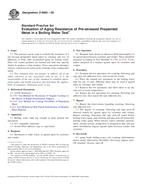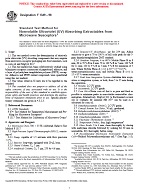1.1 These test methods cover the determination of the maximum dry unit weight and water content range for effective compaction of granular soils. A vibrating hammer is used to impart a surcharge and compactive effort to the soil specimen.
1.2 These test methods apply to soils with up to 35 %, by dry mass, passing a No. 200 (75-m) sieve if the portion passing the No. 40 (425-m) sieve is nonplastic.
1.3 These test methods apply to soils with up to 15 %, by dry mass, passing a No. 200 (75-m) sieve if the portion passing the No. 40 (425-m) sieve exhibits plastic behavior.
1.4 These test methods apply to soils in which 100 %, by dry mass, passes the 2-in. (50-mm) sieve.
1.5 These test methods apply only to soils (materials) that have 30 % or less, by dry mass of their particles retained on the 3/4-in. (19.0-mm) sieve.
Note 1
For relationships between unit weights and water contents of soils with 30 % or less, by dry mass, of material retained on the 3/4-in. (19.0-mm) sieve to unit weights and water contents of the fraction passing the 3/4-in. (19.0-mm) sieve, see Practice D 4718.
1.6 These test methods will typically produce a higher maximum dry density/unit weight for the soils specified in and than that obtained by impact compaction in which a well-defined moisture-density relationship is not apparent. However, for some soils containing more than 15 % fines, the use of impact compaction (Test Methods D 698 or D 1557) may be useful in evaluating what is an appropriate maximum index density/unit weight.
1.7 Two alternative test methods are provided, with the variation being in mold size. The method used shall be as indicated in the specification for the material being tested. If no method is specified, the choice should be based on the maximum particle size of the material.
1.7.1 Method A
Mold
6-in. (152.4-mm) diameter.
Material
Passing 3/4-in. (19.0-mm) sieve and consistent with the requirements of and .
Layers
Three.
Time of Compaction per layer
60 5 s.
1.7.2 Method B
Mold
11-in. (279.4-mm) diameter.
Material
Passing 2-in. (50-mm) sieve and consistent with the requirements of and .
Layers
Three.
Time of Compaction per layer
52 5 s at each of 8 locations.
Note 2
Method A (with the correction procedure of Practice D 4718, if appropriate), has been shown (reference thesis or paper) to provide consistent results with Method B. Therefore, for ease of operations, it is highly recommended to use Method A, unless Method B is required due to soil gradations not meeting Practice D 4718.
Note 3
Results have been found to vary slightly when a material is tested at the same compaction effort in different size molds.
1.7.3 Either method, A or B, can be performed with the material in an oven-dried or wet/saturated state, whichever provides the maximum dry unit weight.
1.8 If the test specimen contains more than 5 % by mass of oversize fraction (coarse fraction) and the material will not be included in the test, corrections must be made to the unit weight and water content of the test specimen or to the appropriate field in-place density test specimen using Practice D 4718.
1.9 This test method causes a minimal amount of degradation (particle breakdown) of the soil. When degradation occurs, typically there is an increase in the maximum unit weight obtained, and comparable test results may not be obtained when different size molds are used to test a given soil. For soils where degradation is suspected, a sieve analysis of the specimen should be performed before and after the compaction test to determine the amount of degradation.
1.10 UnitsThe values stated in either SI units or inch-pound units are to be regarded separately as standard. The values stated in each system may not be exact equivalents; therefore, each system shall be used independently of the other. Combining values from the two systems may result in non-conformance with the standard.
1.11 The vibrating hammer test method may be performed in the field or in the laboratory.
This standard does not purport to address all of the safety concerns, if any, associated with its use. It is the responsibility of the user of this standard to establish appropriate safety and health practices and determine the applicability of regulatory limitations prior to use.
Product Details
- Published:
- 09/01/2007
- Number of Pages:
- 11
- File Size:
- 1 file , 170 KB


